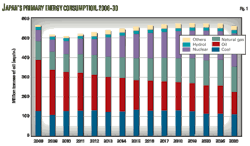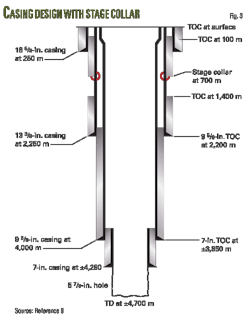New fracture closure-stress calculation leads to improved proppant selection
A proposed calculation of in situ closure stress allows engineers to select more appropriate proppant.
For decades, the calculation for in situ closure stress on proppant has involved subtracting flowing bottomhole pressure (FBHP or estimated FBHP) from minimum horizontal stress. Using these results, engineers have selected proppant based on its tested and published strength to withstand being crushed severely or completely.
But this traditional calculation leads to an incorrect and low closure-stress value.
The author believes that in situ closure stress on the proppant in the fracture should never be less than the closure pressure or minimum horizontal stress of the formation (determined at the time of the fracture treatment).
For future fracture design, engineers should use closure pressure or minimum horizontal stress as a minimum value for the in situ closure stress on the proppant.
Basic calculations
In soil mechanics, effective stress equals compressive stress minus fluid pore (reservoir) pressure (Equation 1 in the equation box).1 2
Reservoir rocks behave the same, and the petroleum industry has used the effective stress concept for calculating in situ closure stress on proppant in the fracture.1 In situ closure stress on proppant is calculated as minimum horizontal (in situ) stress minus flowing bottomhole pressure (FBHP).1-3
Engineers generally calculate the minimum horizontal stress (σHmin), also known as closure pressure (pc) from pressure decline analysis4 5 or from fracture gradient multiplied by true vertical depth (Equation 2). They then use this calculated in situ closure stress for selecting proppant.
Some authors6 have suggested that the calculation should use abandonment pressure instead of FBHP. This will yield a higher estimated in situ closure stress on proppant.
When FBHP is a few thousands to several thousands psi, this traditional calculation has enabled engineers to select somewhat lower-strength proppants for the fracturing treatments.
The few thousand to several thousand psi differences could result in an in situ closure stress greater than the strength of the selected proppants.7 This in turn, might result in a stimulation that produces a fracture with good effective conductivity and fracture half-length (which enhances the productivity of the well) or a limited or ineffective stimulation that produces a fracture without hardly any conductivity and a short or ineffective half-length.
Field measurements
Several authors1 3 8 suggest that minimum horizontal in situ stress (and hence, fracture gradient) decreases as reservoir (pore) pressure decreases.
The author agrees with this assumption but interprets it for a longer period after the reservoir has produced large amounts of fluids, causing depletion to an entire drainage area and resulting in a decline in reservoir pressure for the drainage area.
When designing and pumping a fracture treatment, engineers have considered the minimum horizontal stress (or closure pressure and fracture gradient) as a constant for a point in time at a reservoir pressure. They then determine this minimum horizontal stress (σHmin) at the current reservoir pressure.
When proppant is placed in the fracture and the fracture closes, in situ closure stress on the proppant should be the same as the minimum horizontal stress (or closure pressure, pc) at that time.
Several reasons explain why the traditional method might calculate a too low in situ closure stress on the proppant.
One reason is that there is less in situ closure stress on the proppant during production than during shut-in.
After the main fracturing treatment ends and the fracture closes, in situ closure stress on the proppant equals the closure pressure or minimum horizontal stress (Fig. 1).9 Pressure in the fracture and bottomhole pressure is the same as reservoir (or shut-in) pressure at the time.
As one opens the well for production, FBHP will start decreasing and become lower than the shut-in pressure (which is the reservoir pressure).
The subtraction of FBHP (pwf) from the minimum horizontal in situ stress as currently done yields lower in situ closure stress on the proppant during production than during the shut-in period before the flow.
This is not logical, and therefore, the value of in situ closure stress on the proppant currently calculated by subtracting FBHP from minimum horizontal in situ stress should be incorrect.
Another reason is that pressure is everywhere and acts in all directions.
By subtracting FBHP from minimum horizontal in situ stress, it appears that the FBHP helps support the fracture open. The author, however, considers that pressure acts in all directions (all around and not just in three-dimensions) at any point in the fracture, so that there should not be a direction for the pressure to act in favor or to act against in the opposite direction.
Therefore, subtracting the FBHP in the direction against the minimum horizontal stress (and in the direction against the momentum of fluids flow) should be incorrect.
As a matter of fact, pressure inside the fracture is always lower than the pressure at the opposite point in the formation just outside the fracture face (Fig. 2).2 Therefore, it is illogical to subtract FBHP from the minimum horizontal stress to yield a reduction of in situ closure stress on the proppant in the fracture.
The reasons should support the author's opinion that the in situ closure stress on the proppant currently calculated with the traditional equation is incorrect and leads to an underestimation of closure stress. The underestimation has led engineers to selected not-strong-enough proppants (to withstand the possible actual in situ closure stresses) for many fracturing treatments. This could be one major reason that caused actual fractures to have lower effective fracture conductivity and shorter effective fracture half-length than the designed values.
The author thinks that the current traditional equation for in situ closure stress on proppant becomes illogical because the closure pressure or minimum horizontal in situ stress is evaluated at reservoir pore pressure (or at a shut-in pressure at the time).
As the well starts to flow, wellbore pressure starts to decrease from reservoir pressure (or from a shut-in pressure at the time) to a lower value of FBHP (Fig. 3).10 With lower fluid pressure in the fracture (and lowest near the wellbore), the in situ closure stress on the proppant should increase from an initial value of closure pressure or minimum horizontal stress.11 12
The author believes that in situ closure stress on the proppant should increase by about the same magnitude of the (reservoir) drawdown pressure, and proposes the new equation for estimating maximum in situ closure stress on the proppant as closure pressure (or minimum horizontal stress) plus reservoir pressure drawdown.11 12
Example
The example box illustrates calculations of in situ closure stress on the proppant with the traditional method currently used and the proposed method.
The value of in situ stress on the proppant calculated from the traditional method is much less than the closure pressure (or minimum horizontal in situ stress). The selection of a proppant based on the in situ stress calculated with the traditional method may subject the proppant to its very upper strength limitation or beyond its strength limitation.
Acknowledgment
The author thanks BJ Services Co. for the permission to publish this article. ✦
References
1. Gidley, J.L., Holditch, S.A., Nierode, D.E., and Veatch, R.W. Jr., Recent Advances in Hydraulic Fracturing, SPE Monograph Vol. 12, Society of Petroleum Engineers, Richardson, Tex., 1989.
2. Economides, M.J., and Martin, T., Modern Fracturing Enhancing Natural Gas Production, Energy Tribune, Houston, 2007.
3. Evaluation of Impacts to Underground Sources of Drilling Water by Hydraulic Fracturing of Coalbed Methane Reservoirs, Appendix A, Hydraulic Fracturing White Paper, EPA 816-R-04-003, US Department of Energy, June 2004.
4. Nolte, K.G., "Determination of Fracture Parameters from Fracturing Pressure Decline," Paper No. SPE 8341, SPE ATCE, Las Vegas, Sept. 23-25, 1979.
5. Sookprasong, P.A., "Plot procedure finds closure pressure," OGJ, Sept. 8, 1986, pp. 110-12.
6. Montgomery, C.T., and Steanson, R.E., "Proppant Selection—The Key to Successful Fracture Stimulation (Revised)," Paper No. SPE 12616, SPE Deep Drilling and Production Symposium and Technical Exhibition, Amarillo, Tex., Apr. 1-3, 1984.
7. Sookprasong, P.A., and Elbel, J.L., "Hydraulic Fracture evaluation in a Geopressured Reservoir," Paper No. SPE 13816, SPE Production Operations Symposium, Oklahoma City, Mar. 10-12, 1985.
8. Elbel, J.L., and Mack, M.G., "Refracturing: Observations and Theories," Paper No. SPE 25464, SPE Production Operations Symposium, Oklahoma City, Mar. 21-23, 1993.
9. Hansen, J., Post-Job Report—BJ Services Co., July 6, 2009.
10. Earlougher, R.C. Jr., Advances in Well Test Analysis, SPE Monograph Vol. 5, Society of Petroleum Engineers, Richardson, Tex., 1977.
11. Sookprasong, P.A., "In situ Closure Stress on Proppant in the Fracture, a Controversial New Thinking," to be presented in 2010.
12. Sookprasong, P.A., "Misconception leads to Underestimation of Closure Stress on Proppant in the Fracture for Decades," to be presented in 2010.
The author
More Oil & Gas Journal Current Issue Articles
More Oil & Gas Journal Archives Issue Articles
View Oil and Gas Articles on PennEnergy.com




